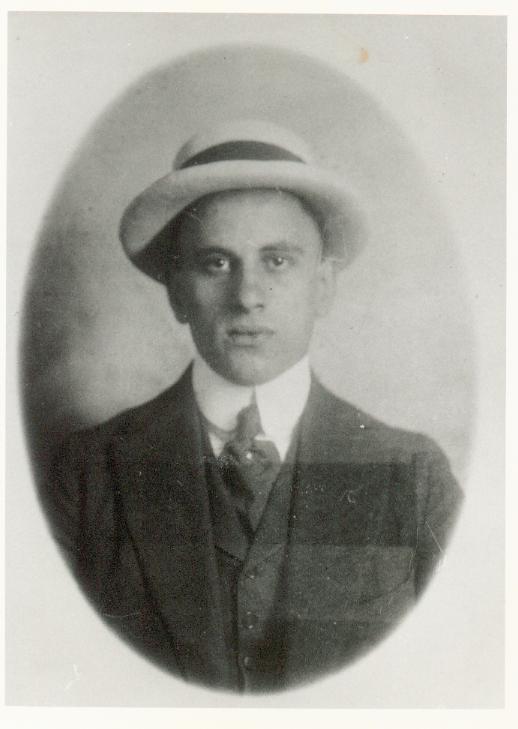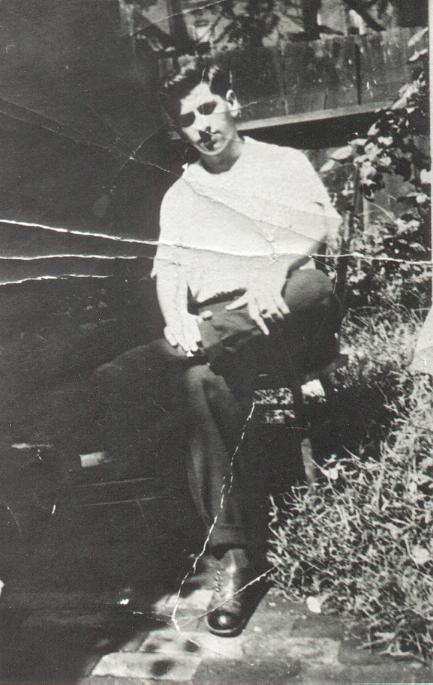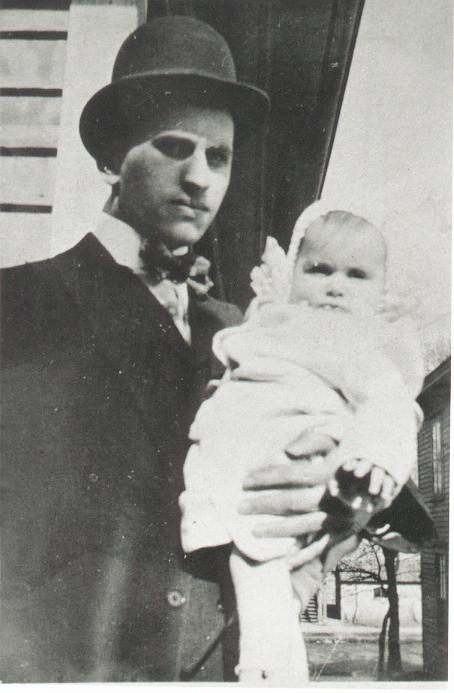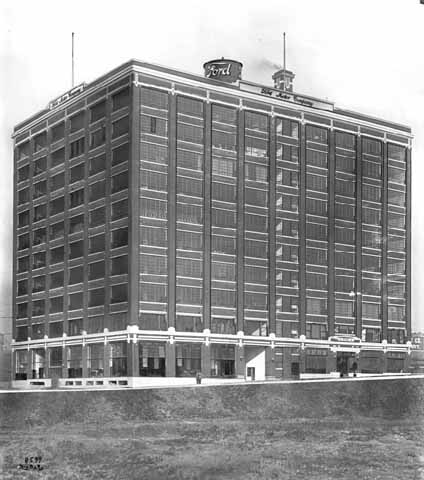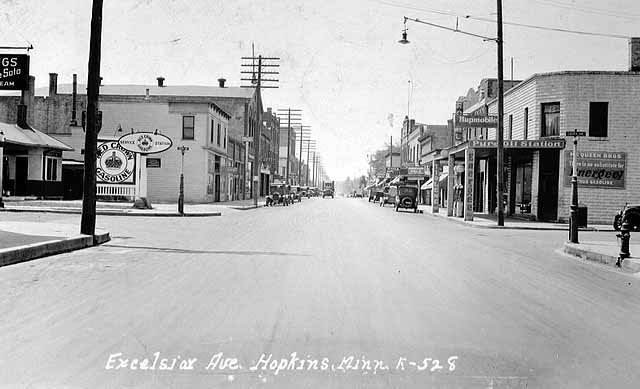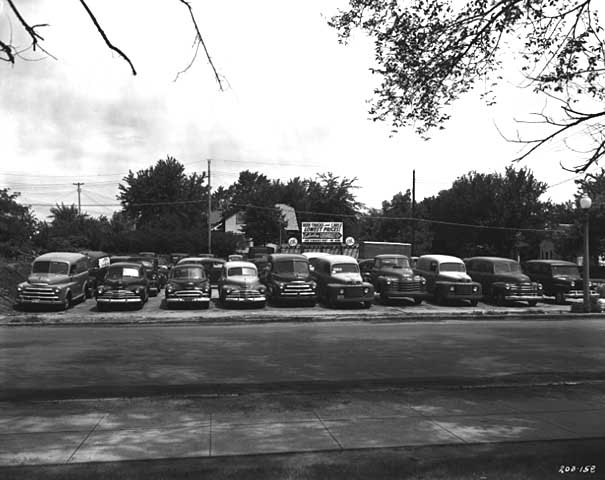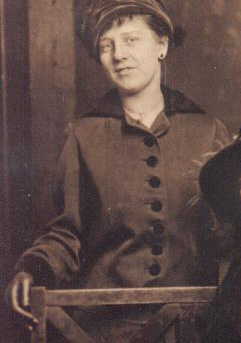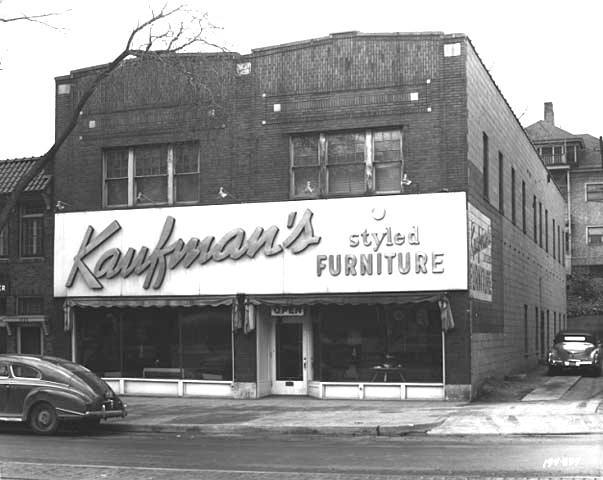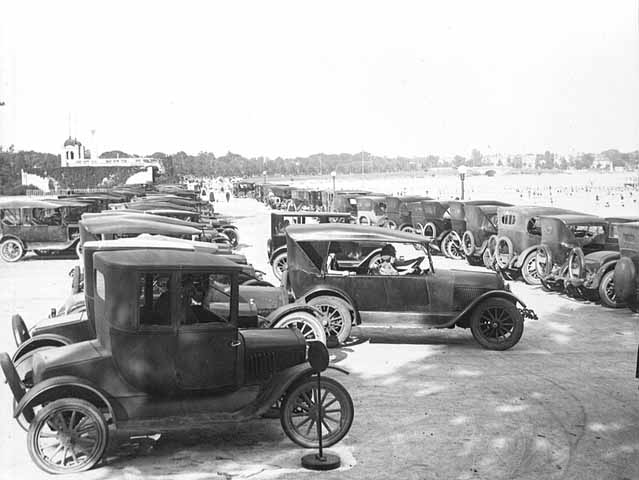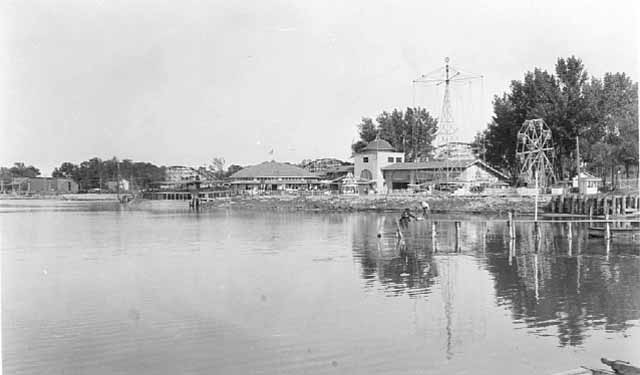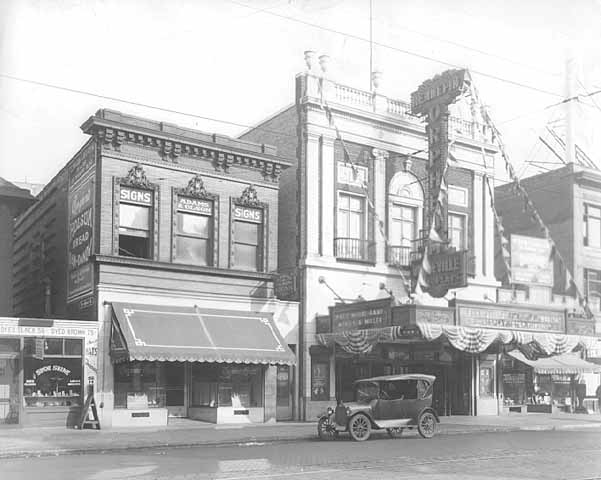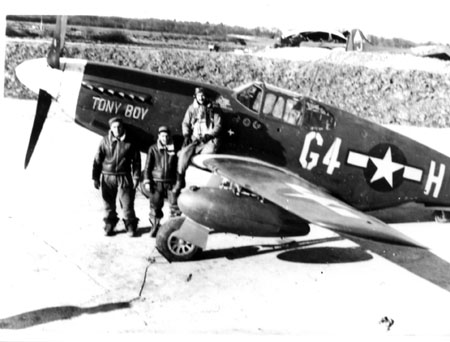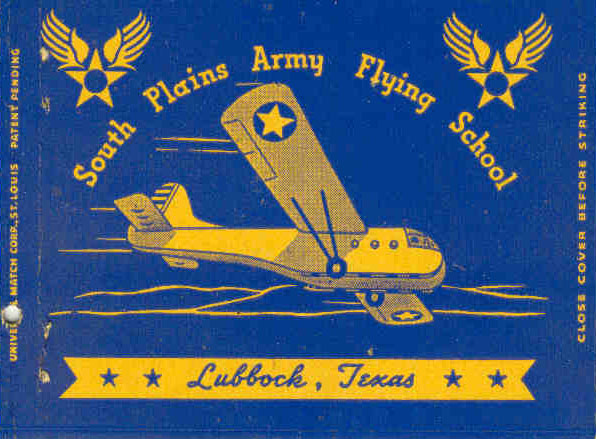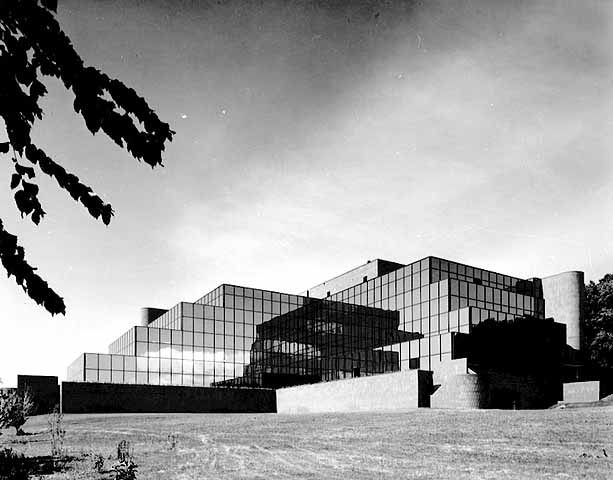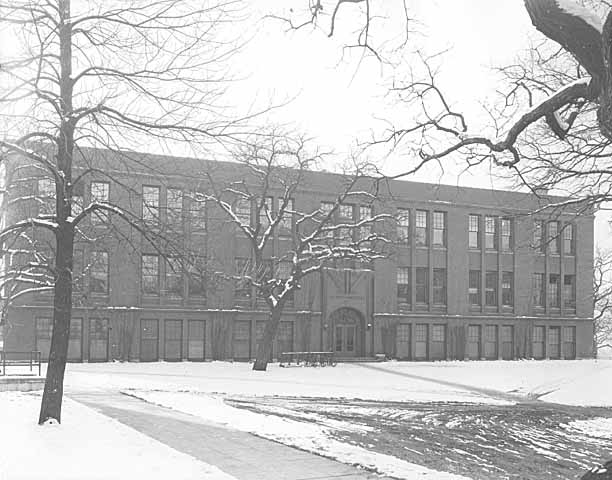|
|||
|
The reader will forgive me if in this subchapter I go into further detail because Max and Ida are my own great-grandparents. Max Grossman, the youngest of Moishe and Temma’s four children, was born in Minneapolis on March 10, 1895, although his birthday is listed as February, 1895 on the 1900 Federal Census. His correct birth date is confirmed by the Social Security Death Index (social security no. 469-30-1494).
Max Grossman, circa 1915 I do not know whether Max was born at home, but at the time of his birth his parents were living at 609 North 2nd Street. As a young boy Max shared a tiny room with his brother, sisters, parents and other relatives in a number of tenement-like flats. (See “Moishe and Temma Grossman” above). He attended elementary school in Minneapolis until he was 11 years old, at which time he moved to St. Louis, Missouri with his family. There, according to his eldest child Marion Cohen (17 Aug 1916-), he worked for the railroad as a telegraph operator, although she does not know when he started the job. He had his bar mitzvah in 1908, the year before he and his family moved back to Minneapolis. The Grossmans returned to the Twin Cities just in time for Max to enter high school at 14 years old. When Moishe opened his first butcher shop on 602 North 5th Street in 1910 Lou was already working for L. S. Donaldson Company. In all likelihood Max helped his father out in the shop, delivering meat and taking orders. He shared a single cramped room with his brother and parents which was attached to the business. I am unclear as to whether Max graduated from high school, but if he did it would have been in June, 1914, shortly before the outbreak of World War I. The earliest securely datable photograph of Max is from circa 1913.
Max Grossman, circa 1913 In 1915 Max married Ida “Chaika” Kaufman (3 Jan 1896-Mar 1966), the youngest of the five children of Morris and Bessie. They were only 20 and 19 years old respectively at the time.
Ida and Max Grossman, Jennie Berman Grossman with son Norman, Hattie Grossman Bierman with daughter Rosalee, circa 1916 Within a year the young couple had a daughter, Cerise Marion (17 Aug 1916-). Marion does not know when her parents met, but she told me that they had lived in the same community on the North Side. As I stated above, Max was living with his brother Lou in a duplex at 607 Plymouth Avenue North by no later than 1915. This was almost certainly Max’s first home as an emancipated, married man.
Max
Grossman with infant daughter Marion Grossman, 1917 My grandfather Norman Bud (5 Apr 1921-) recalls that his father got a job with Ford Motor Company at about that time. Norman Grossman, Lou’s son, remembers that at first Max worked on an assembly line as a manual laborer, but eventually rose to a higher position. Marion recounted that while Lou was still working for L. S. Donaldson Company Max was “selling automobiles for Ford from door to door, like a magazine salesman”. Thus, it seems that Max began on the assembly line and was subsequently promoted to door-to-door salesman. According to the Fourteenth Census of the United States (1920), Max, Ida and Marion rented their home at 913 Elwood Avenue North. Both were born in the state of Minnesota and could read and write. Their mother tongue was English. Like Max’s parents, Ida’s were Yiddish-speaking Jews from “Russia”. Unfortunately, Max’s occupation is illegible on the form, however it is stated that he worked for a wage and not a salary. We can be certain that he was still selling Fords. The neighborhood in which he and his family lived was inhabited by a mixture of Jews and non-Jews. Curiously, there were two other Max Grossmans living in Hennepin County in that year, one of whom was also born in “Russia”. According to Marion, Max may not have been drafted into World War I because he was married, however she is not certain. In 1917, when the United States entered the war, he was already 22 years old, slightly older than recruitment age. He was in excellent physical shape. Ida gave birth to a second daughter, Evelyn, in March, 1918, but unfortunately the baby died in May. This was a very painful event for the family, especially Ida. Marion remembers that in the aftermath of the tragedy the family went to live with the Kaufmans for a short period of time, after which they rented a flat not far from them. Grandpa believes that at the time he was born (1921) his family lived in an apartment building on Fremont Avenue South, but he is unsure of this. What is certain, however, is that by late 1924 the Grossmans lived at 1427 Knox Avenue North. According to the Minneapolis city directory, in that year and part of the next Max was a salesman for Howard & Horton, a Ford dealership. In 1925, at the age of 30, Max went into business for himself, starting a Chevrolet dealership in Hopkins, Minnesota. In my interview with him Grandpa told me the story of his father’s business career: “My Dad was a tall man, and he was very nice-looking—a handsome man—and he went to work very early, and he became a secretary on the railroad. And then he saw an ad in the newspaper that you could go to work at Ford Motor Company and get five dollars a day, so he went over there and he applied for the job and he got the job.
Ford Motor Company, 400-block of North 5th Street, photo 1914 or 1915 [At that point] he was either married or just got married, because he was about 20 when he got married. My mother was young, 19... My recollection is that he went to work for Ford in 1915. And he would comment many times to me that he was the only Jew working for Ford Motor. They were overtly anti-Semitic... and he worked on the line as a production worker. There were no dealers in those days. The building still stands, on 5th Street...
Ford Motor plant, sales room, 1925 All Ford factories looked the same throughout the country. That was before the concentration of production in Detroit. And so he worked there. And on the Jewish holidays they would post a sign. Anybody who’s absent this day, this day and this day, is fired!... But he worked it out, and apparently he worked it out very well, because thereafter Ford decided to have salesmen, and they formed a sales force. But their sales force were people who would knock on doors and say ‘Do you want to buy a Ford?’ Well, they needed somebody for the Jewish area so they picked him... And he became—that’s how he got in the automobile business—[the Ford representative] for North Minneapolis. He went from door to door selling Fords.” Harold Irving (26 Apr 1926-), Max and Ida’s fourth and last child, told me that at Ford Max “worked hard, seven days a week, probably five, six nights a week... One of the reasons he got into the car business is because it paid five dollars a day, and that was a fortune to most of these people.” Harold confirmed that his father started at Ford “in the form of assembly or painting...manual labor, and then moved into the office. “He wanted a Ford dealership. They wouldn’t give him one because he was Jewish. And this is what I always heard. And when he checked around, Chevrolet was the only one who would give him... a franchise. Ford wouldn’t give him one. And Hopkins was the spot that they gave, which turned out to be one of the best spots in the state of Minnesota... Suburban Chevrolet.” Grandpa continued, “During the Depression my Dad’s business was a very small business. He was an automobile dealer. Lou got into the business, oddly enough, four years before my Dad,” and ended up as a Ford salesman. “And then there was a franchise called Chevrolet... Ford wouldn’t give a franchise to a Jewish person, but Chevrolet and General Motors would because they needed dealers. And I think there was kind of an agreement that they would go into business together, my Dad and my uncle, but it never happened… Instead my uncle made as his partner a mechanic, because, you know, you had to service the cars... So he could sell’em but he couldn’t service’em… Grossman Chevrolet was for many years the biggest Chevrolet dealership in the state of Minnesota… But at that time the only franchise [Max] could get was out in the country, Hopkins... Suburban Chevrolet.”
Hopkins residential street, 1890 Marion Cohen explained: “Max went into business for himself in 1925 or 1926. He was a Chevrolet dealer in Hopkins.” He operated the business by himself without the help of any relatives. He had mechanics and salesman as well as an office girl. He put the whole thing together himself. Marion does not remember how many employees there were. She told me that the business was not an immediate success. After 1929 the Great Depression had a negative effect. The Depression years were tough, “but he kept the doors open.” Max never closed shop. “He evidently was very good at what he did. He was basically very honest. It was very difficult in Hopkins. There was a lot of anti-Semitism… We lived there. We were the only Jewish family.”
Picking rasberries in Hopkins, circa 1900 When I asked Marion how they ended up in Hopkins she responded, “Because he had no other choice! That’s all they would give him... Most of his business was consummated in Minneapolis.” In the early years as he was developing his business Max could not afford to own a new Chevrolet himself, even though he was a Chevy dealer. According to the 1927 Minneapolis city directory, Max and his family lived at 1519 Queen Avenue North, very near Grace, Lou and the Marcus’. Marion remembers that their house was a very nice duplex. Evidently, Max commuted from North Minneapolis all the way to Hopkins in the first year or two after starting Suburban Chevrolet. Grandpa explained to me that Hopkins “was the country. It used to take 45 minutes to go from Hopkins to downtown Minneapolis before Highway 7 came into existence. It was a job... And then he had to move to Hopkins because the factory demanded that. And we lived in Hopkins for five or six years until your Aunt Marion [reached adulthood]”. Grandpa added, “My father got this franchise [Suburban Chevrolet]—and I’m sure that Lou must have helped him get it—but it was in the country and it was very small… Your clientele were farmers. And he was probably the only Jewish businessman in Hopkins... That was a Czechoslovakian community. Even when I came back from the army and went to work there it was clear that being Jewish was very different in that town.” In the beginning the going was tough, and not being from Hopkins did not help. Harold commented, “[Max] didn’t rely on the market out there [in Hopkins]. He did some of his business in Minneapolis.”
Hopkins,
Excelsior Avenue, circa 1929 Grandpa continued, “So the business was very small.” The first dealership was under 1,000 square feet. There was “room for two mechanics, no parts department, one bookkeeper and two cars on the showroom floor, and that was it. “And then he moved to the big building, which was 28 feet wide by 40 feet long, down a block.” He had it built and moved there in 1928. The second building “was not very much bigger, but at least it was built as a dealership… And the whole building covered the whole block when we were done with it. That was done over a period of years.”
Suburban Chevrolet Hopkins used car lot, 1951 Since Marion was about 9 years old when her family moved to Hopkins she can recall many details that her two brothers may have forgotten. They lived in a “nice house. There you had a house because they didn’t have multiple dwellings there at that time... It was right across the street from the garage. It was on, I think, 11th. I’m not sure.” In the 1920’s Hopkins was a small town of about four to five thousand people, primarily Bohemians. “It was a raspberry capital, and I used to go out as a kid and pick strawberries and get twenty-five cents for picking a lug.” Farm life was very close at hand, but not in all directions. The streetcar ran parallel to Excelsior Boulevard and through the town. “There was a lot of empty space between Hopkins and Minneapolis in those days.” Her youngest brother Harold was in a buggy at the time. Marion took care of him after school and pushed him around Hopkins. The house itself was a single-story bungalow with an open front porch and a basement, kitchen, dining room, and living room. There was an ice man, milk delivery, and an ice box. Mail was delivered twice a day. They also had a telephone. Marion Cohen remembers the period leading up to the Depression. She told me that her family had no trouble getting food on the table, but “there were no frills.” Their lifestyle was very simple and rather austere, “except my mother had help in the house.... She had a girl most of the time... mostly in the 1930’s and after the Depression... when we moved back to Minneapolis.” Max would get up early in the morning. “He usually worked at night. When we lived in Hopkins he would come home for dinner, because we lived across the street from the garage. But when we moved back to Minneapolis it was totally different, because it was a long haul.” Ida, meanwhile, had plenty of leisure time during the day. Max didn’t spend a lot of time with his wife Ida, only in later years, “but during they’re younger years no.” Max was busy. Marion was in and out of her father’s workplace all the time, but she cannot recall many details of what the business was like in the 1920’s. “There was an office and a little balcony and there was a shop in the back.” Max was usually to be seen selling the cars. In the summer of 1930 Max and his family moved back to North Minneapolis, this time to 1245 Penn Avenue North, where they remained until 1941. Marion says they moved back “because my mother was tired of living in Hopkins and they wanted me to go to a school where their were Jewish kids, primarily,” and where the boys could go to Hebrew school. The house was a spacious duplex, and the Grossmans lived upstairs above a family which owned a newspaper stand. According to Marion, her parents mixed with their neighbors but never had friends over for dinner, only family. Judaism was extremely important to Max, as it was to his brother Lou, and he wanted his children to be educated in the tradition of his people. For many years Max and his family kept kosher. The meat used to arrive at their home by street car at times. Passover was spent with Moishe and Temma. Marion recalls, “Well, we always went to Mikro Kodesh... the orthodox synagogue.” Max was “very involved” in that synagogue. He served the congregation in a number of capacities over the years, including as director of the retirement fund and eventually as chairman. Marion continued, “He was basically very orthodox, very traditional as far as worship was concerned”, although he did not maintain this level of observance his whole life. At Mikro Kodesh “the women sat upstairs and the men sat downstairs.” Marion sat upstairs with her mother Ida. At High Holiday services all the kids united in the shul. “You weren’t necessarily in the synagogue all day long. The grown-ups were, on Yom Kippur, but the kids didn’t.” In his later years Max went to the same synagogue as his children so that he could spend the holidays with them, even if it meant attending a non-Orthodox shul. Coincidentally, just a few doors down from Max and Ida lived another family of Grossmans, at number 1215. These were Sam and his children Morris (Morrie) and Rebecca. Sam once told Harold that they were related, but I have been unable to determine how. Rebecca, a stunning-looking woman who supposedly resembled Elizabeth Taylor, married a number of times and was last seen by Harold in Palm Springs. Morrie was Grandpa’s accountant for many years. For the most part Max and Ida lived very traditionally. They took no part in “the roaring 20’s”, flapper culture, the Charleston, and all the rest, unlike Art Kaufman and Lou. Max and Ida’s closest friends were relatives, especially David Kaufman and his wife Sarah. Marion commented: “But my father worked day and night. There wasn’t much room for social life as you picture it. There was no such thing as coming home for dinner and spending the evenings… [only] very seldom.” In his 70’s he was still working, even though it was no longer necessary. Work was “his priority, above everything and everyone.” The family never went out on the town, to restaurants or the cinema. Entertainment was always at home. Aside from a single trip up to a friend’s farm in northern Minnesota, the kids were never taken on vacations. Max and Ida preferred to go on holiday alone together. According to Marion they used to go to California, and then out to a spa in Hot Springs, Arkansas, but they would always stop in Las Vegas on any trip out west. They preferred to travel by train, and would often leave in springtime. They also went to Florida a number of times, but Ida preferred California—San Francisco, and especially Los Angeles. They would visit with friends while Max played golf, his favorite diversion. In the later 1930’s, with the Depression on the wane, Max and Ida would sometimes rent a cottage on one of the bays of Lake Minnetonka. The Kaufmans would come out to visit, and sometimes Sam and Hattie Bierman. Harold remembers what North Minneapolis was like when he was growing up in the 1930’s: “The area [where we] lived was the hub of... almost like a shtetl-like community. I mean, as I remember… that area was almost cleansed of anything that wasn’t Jewish... If you took the borders of 6th Avenue North, Glenwood Parkway, Emerson Avenue and maybe 19th Avenue North—that was like a shtetl! The Finns had their area, the Swedes and the Polish. Everybody had their own... I tell you, that was quite a life, in retrospect. It was really different, very interesting. And its a period of time that will never be repeated.” As far as Max was concerned, while Harold was growing up it was “work, work, work. Its always work, work. He was a hard worker.” He did not do much to relax. He just worked. He really did not have any free time. “I mean there were periods of literally months… I never saw Max. Well, I’d get up and go to school, and he’d still be in bed. And I’d come home at dinnertime, and he wasn’t there ‘til 10 o’clock...and then at 10 o’clock he’d eat dinner. So we were on different schedules entirely.” Growing up, Harold shared a room with my grandfather Bud and great-great grandmother Bessie Kaufman (died 1932-33). Grandpa and Harold shared one bed while Bessie occupied the other. Marion, who had her own room, did much baby-sitting for her two younger brothers. She adored living with her grandmother. As for Max’s personality, I asked a number of relatives who knew him well what he was like. Irene Silesky told me he was a very talkative, friendly person. Francis Yedidia recounted that he used to visit her and her family in San Francisco when he went out there for the auto shows. She said he was tall with dark hair, an outgoing man—different from Lou, but she could not explain how. Neither Max nor Lou were intellectuals, but were excellent businessmen. Marion recalls that her father Max was tall and dark, big for his generation. “He was outgoing and he was talkative because he earned his living as a salesman.” He was not even-tempered and was prone to blow his top from time to time. Arthur Bierman remembered that Max was sometimes a guest in his house in St. Louis because it was a mandatory stop between Minneapolis and Hot Springs, Arkansas, where he and Ida liked to take sulfur baths. He too emphasized that Max and Lou “were wonderful businessmen.” As Max got older and became more successful in his business he was able to take time away from work to pursue other activities. According to Marion, first and foremost among those activities was golf, which he played at Oak Ridge Country Club—a purely Jewish institution located in the western suburbs, where much of the Jewish community moved after World War II. Marion told me that by the time Max joined the club he was already in his 50s. “As he got older he LOVED to play golf. It was his favorite thing to do.” Marion asserted that “He also loved to sing. He had a good voice, and my mother played the piano.” Max would sing while Ida played. They did not do this very frequently, however. Max liked to sing popular songs, “the sheet music stuff.” Another pleasure which Max enjoyed was cigars, which he smoked constantly, but only at home. In addition to Mikro Kodesh, Max got involved with the Jewish Federation, the United Jewish Appeal and a number of other Jewish foundations. In 1975, when Max had been in business for 50 years, the town of Hopkins honored him with a festival! Grandpa Bud told me: “The town [of Hopkins] got together and had a Max Grossman Day. Best thing that ever happened to him in his life! And they ran full-page articles, and they wined him and dined him and had a [huge party].” Rona Jean Grossman, Harold’s wife, commented, “They had a big parade... They had him riding in a convertible… He was considered the senior businessman of Hopkins. It was 50 years!” Max was 80 years old in 1975. When I asked Marion whether Max ever retired from work, she replied, “In his head he never retired, until almost the very end.” Max outlived his wife Ida, who passed away in 1966, by over 15 years. In 1970 or 1971 he married a second time, to Ann Weinblatt (died 1982), a Vienna-born Jew who had been widowed some years previously. Max had played golf with her late husband for many years and had been friends with her for a long time. At the end of his life Max lived in a nursing home where he gradually lost his senses because of a series of strokes. Lou, who suffered from Alzheimer’s, was Max’s next door neighbor. Sadly, the two brothers were yards apart but were not able to spend time together and, in the end, were incapable of recognizing one another. Max passed away on Christmas Eve, 1981 at the age of 86. Ida Kaufman (3 Jan 1896-Mar 1966), the youngest of five children, married Max in the year 1915 when she was only 19 years old.
Ida Kaufman Grossman, circa 1918 Her parents, Morris and Bessie “Bassa” Kaufman, owned a furniture store in Minneapolis. Their children were Arthur (married Florence), Jack (married a Cohen), David (married Sarah), Joseph (13 Mar 1894-Dec 1973, married Elsie) and Ida.
Kaufman's Furniture, 1920 Lyndale South, 1950 Grandpa had the following to say about his mother’s family: “The Kaufman family was a great family, an interesting family. They all lived in Minneapolis with the exception of Jack Kaufman, who lived in Omaha.” Grandpa does not know where Morris Kaufman came from, but suspects it was Eastern Europe. Bessie, whose maiden name was Goldstein, may have come from Grand Forks, North Dakota. “We saw more of her family, my mother’s family, than we did of my father’s family… My grandfather [Morris Kaufman], who died well before I was born, was in the furniture business, so all of his sons went into the furniture business. “The only one who owned a furniture store was Art... and Art was the oldest son, and Art was a very exceptional guy. First of all, they were all handsome people... the Kaufmans, including my mother... stunning. They were ALL handsome people. And Art was the most handsome... a very handsome guy... He was married to a woman by the name of Florence. Art was a person of great taste. He had two furniture stores. He had an antique furniture store and he had a regular furniture store, and he was successful. And he lived on the second floor of a beautiful apartment, not on the outside of where the Jews live, but close to it. And he was a cracker jack of a bridge player—fabulous bridge player. All the Kaufmans loved to gamble including my mother. “One day Art came home—and I used to play a lot of bridge when I was young—and we would go over to Art Kaufman’s place sometimes, I and my friends, and we would play bridge there.” He had a beautifully furnished home. He had great taste. “One day he came home and he said to his wife, ‘I want a divorce’, just like that! They had no children. He moved out of the house and just disappeared, for maybe fifteen years, and it was a long time. And one morning Harold comes in to see me. He says, ‘Bud’, he said, ‘Read this!’ And there’s a blurb in the newspaper: ‘Arthur Kaufman arrested for booking.’ I said [laughing], ‘Are you saying that you think that might be Uncle Art?’ He says ‘Yes! It might be!’ By G-d, we ran him down. And what he had done was he had just moved out and went down to live in what was then a nice neighborhood, 15th and Nicollet. There were some lovely hotels around Loring Park—now they are nothing—and he lived there. And he had enough money just to get along. And he would work part time in a big drug store there on Nicollet, and he was booking! And they did arrest him! Well, we got him out. That was the beginning of our relationship with Uncle Art! From then on in he came to the house. He hung around. He was there all the time, and we were very close.” Art took Grandpa’s son Richard (my Dad) fishing and would teach him how to gamble. “And the kids loved him And when he was young... he ran away from home and he joined Pancho Villa in Mexico! Oh he was an adventurer [laughing]... And then he tells these stories [laughing]... And then he came back and went into his Dad’s business… But Art would spend hours with the kids, teaching’em card tricks... You know what he used to say? [laughing] ‘I made my living gambling, I did...’ You know he must have lived to be 150 by all the things he said he did!” Morris and Bessie’s second son, Jack, lived in Omaha, where he married Marion Cohen’s sister-in-law. Grandpa told me that “He sold hats. And in those days… he would buy samples or get samples, and then he would get in a car and he would be gone for five days, and sell hats. Everybody said that Jack was a lady’s man. He was a HANDSOME guy, handsome guy. And he had one son whom I don’t see. But when they were alive they used to come visit once a year, twice a year, stay at the house.” He died of a blood clot in his 70’s. According to Grandpa, David Kaufman “worked as a furniture salesman at various stores in town. [They had] three children, one of whom is... Marion’s age, Theresa. She married a very nice man, and she’s still alive.” David died of a heart attack in his 80’s. Marion Cohen
told me that Joseph, the fourth son of Morris and Bessie, “had no children.
He was married to a woman named Elsie (4 Oct 1889-Sep 1979) who was very
close to the Kaufman family. And
Joe had aspirations when he was young of being a singer and an entertainer.”
Grandpa commented, “Joe was a VERY good-looking guy—and I keep saying
that because they were! And Joe was
an entertainer for awhile. He could
sing in two voices [simultaneously], and there are clippings floating around.
I don’t know whether I have any of them.
But then he went into the furniture business.
He was married to Elsie. Elsie
was German, not Jewish. Had no
family. Wonderful woman… Joe had
a very serious heart condition from a young age… I
was in an ambulance with Joe… and I remember clearly sitting in the back
taking Joe to the hospital, from which he wasn’t going to come out alive, and
bending over and saying, ‘Uncle Joe, I want you to know that we just had a
baby son, and we’re going name him Joe.’
So your name will always be there, [thinking] he wasn’t going live.
Well, he lived another twenty-five years!
And that was Joe [laughing]! And
then Elsie lived another four or five years after him. “…[The Kaufmans] all had heart problems but they didn’t know what going to a doctor was…, but they lived a long time anyhow! Art lived into his 70’s. Jack lived into his 70’s. Joe lived into his 80’s. Dave died about 70.” Marion told me that her mother Ida was “was small, blue-eyed, petite, but always fought weight….” She had a great sense of humor and was very sociable. She was not involved in any organizations and usually remained at home. When she cared to cook she was good at it. “My mother was not too cloths conscious. My father was.” He was very fashionable for many years. All three of Ida’s surviving children liked to point out that her “greatest source of entertainment was playing poker.” Marion commented, “She was a game player. She played during the day primarily, and sometimes at night. She played several times a week. She played poker, pan... Whatever there was she’d play.” They played very small stakes. Nobody had any money. She would have over her female Jewish friends, all women. They would play cards in the afternoon for a couple of hours, not all day. Gene Stillman, Harry and Grace’s daughter-in-law, stated that Ida played cards like “a regular fellow”. Harold was more emphatic: “She was a legendary card player. In a way, she would play cards with a frequency of—Well let me say this… If a man worked as hard as she spent playing cards she would have been one of the most successful people in the world! [laughing]” Harold’s wife Jean added that Ida loved to play cards for money, “not a couple times a week, like four to seven times a week!... They had different groups.” And Ida was in all of them. Later in her life she and Max went to Las Vegas every year.
Grandpa recalled, “…My mother used to play poker two or three nights a week. I never realized it, but even to this day [laughing] I meet people who say, ‘Your mother and my mother used to play cards together!’... And my Dad never gambled.” Marion highlighted her mother’s lively sense of humor with a wonderful anecdote: “She [Ida] loved to gamble, and loved to go to Las Vegas. Never flew. Always was in a train. Never, never got on a plane. She had a phobia. She didn’t like escalators either… And they always went to the Sands [casino], and she loved to gamble.
Sands Casino, 1960’s postcard And she would go down in the afternoon... before it got very busy, just to warm up. And this particular day Sammy Davis Junior was dealing. She loved to play blackjack... He was ‘kibbitzing’. He was playing around. It was the afternoon, and the casino wasn’t that busy. We’re going way back into the early 50’s now. And he was performing at the Sands, and he was just horsing around. And my mother always sat the first seat. She got the first card, and they knew her there... So anyway, she asked for a card, and he gave her a card. And she went ‘Oy vey!’. You know, she put her hand to her cheek and said this in ‘Jewish’. So Sammy Davis looked at her, and she was blue-eyed, and fair-skinned. She was not Semitic-looking at all. And he looked at her and he says ‘You know, you don’t look Jewish!’ And she looked at him and said ‘Neither do you!’ And that really happened.” Ida traveled to Las Vegas many times. Max would accompany her although he did not particularly like to gamble. Sometimes she would go out and visit family or friends, or else she would meet them at home. Marion told me another fantastic anecdote about her mother: “Ida was going to the Nicollet hotel, to a luncheon, and they were pouring cement on Nicollet Avenue. And she ignored the fact that they were doing it. She took a right hand turn and she got stuck! My mother never should have ever been allowed to drive anyway. I remember when she was first learning how to drive—I must have been about five, six years old—in a Model T. And she was supposed to go forward, and she went backwards instead, and wound up on the sidewalk. I’ll never forget that… And, fortunately, we were all sitting on steps, so we weren’t hurt! She was really somethin’ else at times. But any way... she ignored it. All she knew was that the entrance to the hotel was where it was and she was gonna go to the entrance! And the car got stuck.” Marion was not living in Minneapolis at the time. “And coincidentally there was a TV camera there, a news camera... I would say it was in the 60’s... Well, they put her on TV... [which] shows her going, ‘Oh my G-d!’. That was a habit of hers. She would put her hand to her face... and she shrugged her shoulders. And they carried her—the police or the workmen—carried her. [She yelled] ‘Just call my husband. He’ll take care of the car!’ She gave the information, and they carried her into the hotel and she went to the luncheon. So it was on the news that night. And that was her claim to fame… It was funny because of her reaction. ‘Call my husband, Max Grossman. He’ll take care of the car!’ And he did.” Jean added, “Her picture was in the Minneapolis paper in the cement. I got a copy and framed it. And [Alene, Grandpa’s late wife] came over to my house and said, ‘You’ll never guess what happened today [laughing]’… You know it [made] the national news! People called up. They saw it in other cities.” It was given a few seconds on national news. Max thought it was hilarious. Everybody laughed about it. All agreed that Ida had an extraordinary sense of humor and a lively personality, but she was also a very caring mother and a warm, kind-hearted person. Marion Cohen, who now lives in Encino, California, talked to me about what it was like growing up in North Minneapolis in the 1920’s and 30’s, where she lived until she married Bill Cohen (with the exception of the four years or so that she lived in Hopkins): “When I was very little I paid a nickel to go to the Liberty Theater. I used to take grandpa there.” The films were silent. The owner of the theater was a Jewish guy named Lebedoff. The kids would go to the matinees. “[Lebedoff] used to walk down the aisle and scream at the top of his lungs, and he spoke with an accent. He had been born in Europe, and everyone would imitate him... He would say ‘Quiet! Or I’m gonna throw you out.’... He was so frustrated… The Liberty was something I went to when I was very, very young.” She would be taken there by somebody, or she would be at her grandparents and just walk over there. Traveling by streetcar “was the most comfortable thing in the world... It was public transportation, because you didn’t have automobiles, as a young person…. We used to go to the beach all the time, as a teenager. We’d go down to Cedar Lake, Lake Calhoun...” She and her family would go swimming, in black bathing suits which were typical of the period.
Lake Calhoun Beach, circa 1923 In the summer she would go in groups to the amusement park in Excelsior which used to be there. It had a roller coaster and other rides.
Excelsior Amusement Park, circa 1935 In the winters “We used to walk from 12th and Penn to school, which was almost 3 miles... in below-zero weather.” People lived without fear in those days. Girls did not have to worry about tough guys on the way to school or delinquents. “You never locked your doors. You walked down the street and nobody assaulted you. They might not have liked you because you were Jewish, in Hopkins, but they didn’t lay a hand on you.” In downtown Minneapolis in the 1930’s, in addition to going to the movies, Marion also liked going to stage shows at the Orpheum.
Orpheum Theater, 908-910 Hennepin Avenue, circa 1925 “If you went downtown at night it was something very special. Maybe New Year’s Eve you went to a movie.” People would dress up to go downtown because it was a special occasion. She graduated from North High School at the age of 16. Immediately afterwards she enrolled at the University of Minnesota where she remained for one semester. The year was 1932, and she was the first Grossman in our family to attend university. In 1933 she went to work for her uncle Lou in the office of his finance business. In the 1935 Minneapolis directory I found her under the following listing: “Marion C Grossman sten Royal Finance Co r 1245 Penn av N, right off Plymouth”. Marion met her future husband Meyer Bill
Cohen (22 May 1906-22 Nov 1980) in 1938 through her uncle Jack Kaufman,
who was married to Bill’s sister. Marion and Bill were married by an Orthodox rabbi on August
19, 1939 in Omaha, Nebraska, only days before the outbreak of World War
II. Bill was the eighth of
nine children and “was what is known as a bachelor, in those days. He was in his early thirties, and he was a very warm,
congenial man—very bright, very creative.”
He was tall and dark-haired with brown eyes.
He did not go to college. He
was employed as an appliance salesman for General Electric and worked
directly from the factory, traveling to dealers as a kind of in-between
man. After their marriage
Bill and Marion moved to Omaha, and later returned to live in
Minneapolis for three years. They
then moved to Peoria, Illinois, where they remained until 1947.
They had their first child, Stephen Morris, on June 11, 1941,
followed by Barbara Lee on February 11, 1946.
After a brief period in Minneapolis (1947-1950), the family moved
to Highland Park, Illinois, where they stayed for 22 years.
In August, 1945, when Marion was three months pregnant with
Barbara, she learned that Bill was ill with Parkinson’s disease.
Bill remained very sharp mentally for a very long time but
eventually was unable to work. He
and Marion spent their summers together in Miami in the 1960’s.
They moved to California together in 1975, and Bill passed away
five years later. Her son
Steve married Trudi Emily Feinberg (29 Apr 1945-) and had two sons, Adam
Jon (26 Sep 1969-) and David Aaron (11 Feb 1972-).
Adam married Jean in 2002 and had a son Elijah in 2003 . David married Kathy Mesirov on August 14, 1999 and had a
daughter Isabel. Barbara
married William Cohen and had a son, Ian Matthew (13 Feb 1973-).
After divorcing William she married Barry Feldman in 1982. My grandfather Norman Bud Grossman was born in Minneapolis on April 5, 1921. At Hopkins Public School Grandpa attended Kindergarten and three grades of elementary school. Sometime in that period he remembers “getting a bicycle for a present. We lived across from the dealership [Suburban Chevrolet]—its now torn out—and there was a beer joint, right on the corner of Excelsior Blvd. And we lived in a nice house. It was a nice neighborhood. I don’t think the town had 5,000 people in it at the time… I remember also taking piano lessons, and I took them from the nuns in the convent.” According to Marion, her brother was very musical as a kid. “He had a beautiful voice when he was very young.”Grandpa told me that his childhood home was not a religious household. “It was very secular, although my father was always a deeply religious person.” For awhile Grandpa shared a room with Harold, who was five years younger than him. Marion was five years older. Meanwhile, Max was away most of the time working long hours. Like Marion before him, Grandpa attended North High School, graduating in June, 1938 at the age of 17. He met his future wife Alene Mae Lorberbaum (25 May 1922-2 Sep 1988) “on a blind date. I remember very well. I was 16. She was 15.” He was set up by Evelyn Stone. “Harvey was my best friend and Evelyn was Alene’s best friend... It was in December [1937]. We went to a skating party at Loring Park.” Not long afterwards the two of them starting going steady.
Alene Mae Lorberbaum, 1940 After high school Grandpa went to the University of Minnesota where he graduated with a degree in political science in late spring, 1941 at the age of 20. “They had an accelerated course. I wanted to get my Ph.D. and I wanted to teach... I didn’t like business. I worked a couple of summers around the dealership and I didn’t like it at all.” He had polished cars and performed many other tasks for his father. “I worked there and at the Stillman grocery stores. I used to work all day Saturday, which was like 8 in the morning ‘til 10 at night, and then Sundays, a half day.” Grandpa “went to work, because... at that point I was convinced that we were going into the war... I was convinced, and so I got a job while I was sorting it all out, trying to figure out was I was going to do, and then Pearl Harbor came along. And I told [Alene]—and we weren’t married—that I was going to enlist...” Her reaction was that he was crazy. “I personalized the war and Hitler and the whole thing. So anyway, then the decision came. Then [Alene] said we’re going get married. And I said, ‘Well how can we get married? I’m going into the service. Anything can happen to me!’ Well, we talked it through and decided to get married… I got a temporary job at Minneapolis Moline at this time. So I wanted to enlist and get into the service, but [Alene] still thought that she could dissuade me. Well, the only thing I could get into without her permission, knowing we were going to get married, was the Air Corps. You didn’t need any approval at all… Thinking that through, I didn’t like water. The Navy didn’t appeal to me, so the Air Corps did. And the easiest one to get into was the Army Air Corps. The others required—You know, if you were married when you were called in, you had a problem—all kinds of things. But anyway I enlisted and was accepted in the Army Corps. And then we got married in January of ‘42... I know it was New Year’s Day that I got married because I could get a four-day vacation, a four-day leave. And I was called up—I forget when—sometime in early ‘42, or middle of ‘42... I entered the Air Corps and eventually became a pilot.” Grandpa continued, “I was at the absolute margin of height, the absolute margin of size, weight too... Well, you know, I was only 5’6” and I weighed about 120 pounds... but they needed pilots badly. They really needed them badly… I thought that when I got in I was going to go into pilot training, but I wasn’t. I was sent to a class vacation center for six weeks with a hundred thousand other guys where we took another battery of tests, and they were classified... This was in Texas, just outside of Randolph Field in a place called Kelly.
Fighter pilots at Randolph Air Field with a P-51 Mustang, 1941 And a certain percentage became pilots, a certain percentage became navigators, a certain percentage became bombardiers. Well, there was no way I was going to become a bombardier or a navigator!... Anyway, I qualified very well and I was selected as a pilot, but they warned me that I was small and that my chances of getting through the pilot training program were not all that great, because I was small. You were doing your pilot training for the 13 months... I think. You went to ‘Ground School’. And one thing I knew I could excel in was Ground School, so I had the highest grades in the class [laughs]. I think that’s what helped me get through, although I was a good pilot and I enjoyed it… “I was stationed in the United States in instrument flying techniques... It was very early in the war. Weather was the big problem in the European theater... There was no instrument flight training when I took my training. It was an open cockpit airplane and that was it in the primary stage. The other stage was just a little two-seater with a plastic shuttle on top.
Reese Air Force Base, Lubbock, Texas Then the cutting edge were twin-engine planes which were Cessnas… I spent my entire period in the service instructing students how to fly on instruments.” Grandpa principally taught his student pilots how to fly in bad weather. “And I really liked it... I got out in... January 1 of ‘46 or December of ‘45... I may be a year off. [Alene] was with me all the time I was in the service.” My father Richard Bruce Grossman, Bud and Alene’s first child, was born at a military base in Lubbock, Texas on August 23, 1943.
Lubbock, Texas Army Air Corps After the war my grandfather went on to have a successful business career in Minneapolis. From the late 1940’s he and his brother Harold co-owned and managed their father’s original company, Suburban Chevrolet, expanding the business to include several other dealerships and subsidiaries. In the late 1950’s the brothers co-founded General Leasing Corporation, which came to be called Gelco. The company grew into a large international operation employing thousands of people in several countries, including some Grossmans.
Gelco Corporation world headquarters, Eden Prairie, MN, 1980 My father Richard and uncle Andrew worked
there at a senior level for years.
Gelco, which existed for over 30 years, leased fleets of vehicles
and containers to other corporations, but also acquired additional
businesses. In 1987 the
whole operation was sold to General Electric Corporation.
Meanwhile, the family car dealerships evolved into a company
called the Metropolitan Corporation, which has been run by Tom,
Grandpa’s second son, for over twenty years. Grandpa married Beverly Chalfin (18 Feb 1933-) on December 6,
1992 in Minneapolis, where they live to this day. My grandparents Bud and Alene had five sons over a ten-year period. They are the following: my father Richard “Dick” Bruce, who married Joan Rubin (28 Feb 1946-) on December 5, 1966 and had three children by her, Max Elijah (myself), Abraham Raphael, and Rosa Sophia. My parents divorced in April, 1981 and my father subsequently remarried Lisa Lyons (13 Dec 1950-) on May 4, 1987. Dad also had a daughter named Sandra Newman (6 Nov 1965-) with Sally Greenawalt before marrying my mother; Thomas Mark (1 Jan 1945-), who married Patricia Ann Repesh (10 Dec 1947-) and had two children, Charlie Vincent (28 Dec 1976-) and Elisabeth Anne (10 July 1979-); John Norman (31 Dec 1949-), who married Susan K. Gilman and had two sons, Benjamin Noah (25 Apr 1974-) and Matthew Howard (1 Nov 1976-). John subsequently divorced and currently lives on the West Coast; Andrew Charles (24 Sep 1951-), who married Stephanie Chew (3 Oct 1951-) on December 28, 1974 and had two children, Alene Rebecca (6 Jan 1977-) and Noah Frederick (17 Dec 1979-). After his divorce Andy was married (8 Sep 1996) for a number of years to Lynne Singer (8 Apr 1965-) with whom he had Eliana Singer (27 May 1999-) and Jared David (23 May 2000-); Joseph Clayton (14 Jul 1953-), who married Janine Doyle (5 Mar 1958-) in Sydney, Australia on August 3, 1985 and had two children, Alexandra Velia (14 Mar 1986-) and Jacob Howard (27 Dec 1989-). Max and Ida’s youngest child, Harold Irving, was born in Minneapolis on April 29, 1926. His older sister Marion can remember the day: “I was at home with my grandmother [Bessie] and we were doing the dishes, and we got a telephone call from my father at the hospital... I can remember because it was still light outside, and my grandmother answered the phone and was very excited, and called out to me that I had a new baby brother.” Growing up, Harold attended John Haye and Lincoln Junior High. He had his bar mitzvah at Mikro Kodesh Synagogue like his brother before him. In the fall of 1940 his parents enrolled him at University High School, which was associated with the University of Minnesota.
University High School, Minneapolis Campus, circa 1925 Avis and Howard, Max and Celia Lorberbaum’s children, also went to high school there. Harold graduated at the age of 17 and then enrolled at the University of Minnesota for two or three years, until the fall of 1946, when he went to work in Peoria, Illinois. There he managed a plant that his father Max had purchased. It was called “Revolvo”, had about 6 employees, and manufactured sporting goods equipment and display stands. His brother-in-law Bill Cohen was the salesman of the operation, which lasted a short time. Harold and Rona Jean Menin (30 Sep 1927-) met when they were 16 and 14 years old respectively. Jean, who was visiting relatives in Minneapolis, had a cousin who was in Harold’s group of friends on the North Side. Harold and Jean were still in college when Harold started dating her best friend. One thing led to another and Harold and Jean ended up falling in love. They married on October 31, 1948. Shortly afterwards, more than three years after the conclusion of World War II, Harold was called into the armed forces but was not required to serve. After Revolvo Harold went into business with his brother Bud in Minneapolis. At first they worked for their father Max, but eventually went into business for themselves. Harold and Jean retired to Phoenix, Arizona many years ago and still live there today. They have three daughters: Nancy Ann (27 Mar1950-), who married Irving Glenn Leon (5 Oct 1952-) on August 12, 1984 and had a son, Samuel Hart (12 May 1994-). Nancy divorced and subsequently married Ian Wahl on December 20, 1973 in St. Louis, Missouri; Mary Lee (2 Dec 1951-), who married Arthur Shuman and had two children, David Gabriel (6 Aug 1979-) and Joanna Lynn (23 Aug 1982-); Molly Jane (30 Apr 1955-), who married Thomas W. Levitt and had two daughters, Ellen Louise (19 June 1991-) and Anna Rachel (20 Sep 1994-). |
